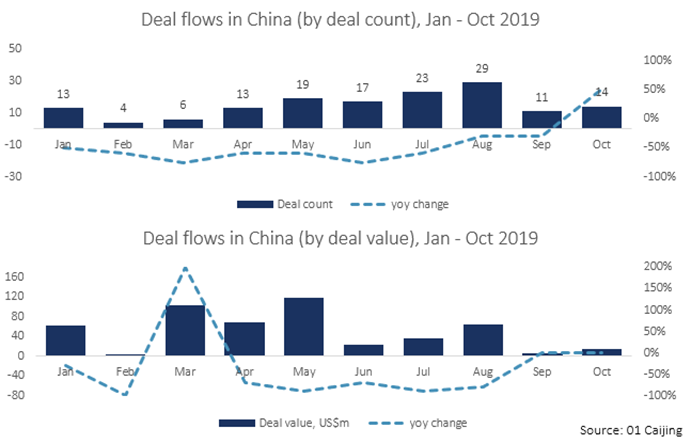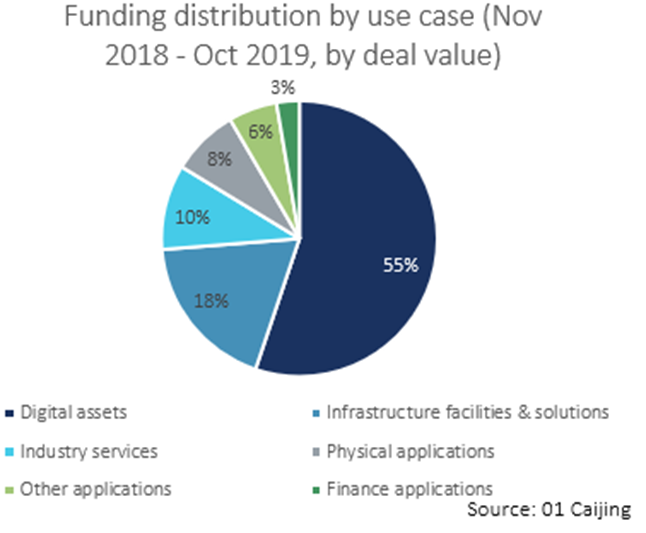Author: Serena Wu, Aves Lair
Summary
- China is the second largest country in terms of blockchain deal funding, following the U.S. Funding surged in 2018, but dropped in 2019, signaling a cooling down of the “hype” in the sector
- Although seed & series A continue to be the majority of funding, an increasing portion of blockchain deals were strategic funding in China
- Digital Assets, infrastructure facilities & solutions, and industry services were the three most popular use cases in terms of blockchain deals
- China named blockchain as a “strategic technology” in its 13th five-year plan, and continues development on Digital Currency Electronic Payment (“DCEP”) and Blockchain Service Network (“BSN”)
Updates in China: deal market and trends: deal flows
China experienced a surge in funding to Blockchain companies in 2017 and 2018. However, in 2019, the market returned to a more reasonable level.
Deal flows experienced a year-on-year drop in both in terms of deal count and deal value in 2019, according to 01 Caijing. Monthly deal count dropped by 30–80% year-on-year, and deal value dropped by 20–100% year-on-year (except for March 2019, when Cannan Inc received US$100m funding).

Investment stages: increasing strategic-round funding
Similar to the global trend, the majority of the deals in China were in seed/angel and series A rounds. However, strategic investment began to increase in 2018, reaching over 50% in 2019, according to 01 Caijing.

Top 10 blockchain deals in China in 2019
The following table shows a list of top 10 blockchain deals in China in Jan-Oct 2019. As discussed above, some of the top 10 deals in 2019 were strategic rounds.

Use case: digital assets ranked first
In Nov 2018 — Oct 2019, the top 3 most invested use cases in China were:
- Digital Assets
- Infrastructure facilities & solutions
- Industry services
Digital Assets remained to be the most popular use case, representing over 50% of all deal value invested, according to 01 Caijing.


Policy updates in China: blockchain Is a “strategic technology” highlighted in China’s 13th five-year plan
Support of blockchain development by the Chinese government dated back to 2016, when blockchain was listed as one of the “strategic, cutting-edge technology” in China’s 13th Five Year Plan of Information and Technology.
Earlier in 2019, China published the “Blockchain Information Service Management Regulations”, which specificies the legality and protocol of regulations on blockchain. In Oct 2019, President Xi pointed out that blockchain should be treated as a “important breakthrough” in terms of independent innovation of core technology and called for pushing the development of blockchain technology and industry innovation, according to Forward-The Economist.
However, the “blockchain innovation” that was advocated by the Chinese government should not be confused with advocating cryptocurrency or ICOs. In fact, China has taken a rather strict stance in terms of ICOs and cryptocurrency. In 2017, National Internet Finance Association of China issued a warning on the risks of ICOs, which include fraud, illegal funding, illegal securitization etc., and urged investors to stay reasonable.
Blockchain Service Network (BSN)
After six months of beta test since Oct 2019, In April 2020, the BSN was officially launched for global commercial use. According to the Blockchain Service Network Development Consortium, BSN was co-founded by the Chinese National Information Center, China Mobile, Union Pay and others. According to its white paper, BSN is the “blockchain version of internet”: a global infrastructure for deploying and running various blockchain applications worldwide.
The founders believe BSN will become “the only global infrastructure network innovated by China, with gateway access controlled by China”, and stated that BSN have the following competitive advantages:
- Save costs of deployment, operation, and maintenance;
- Lower the threshold of blockchain application development;
- Ease of use and convenience for application users;
- Flexible access to the network; and
- Speedy mechanism for connecting to the network.
Since its beta test in Oct 2019, over 2,000 developers tested BSN. BSN currently has 128 public nodes, 76 of which are connected, 44 are under construction, and the remaining 8 are across six continents. The founders plan to maintain 200+ nodes in the network by 2020.
Digital Currency Electronic Payment (DCEP)
In 2014, People’s Bank of China (PBOC) started to work on a digital currency representing RMB Yuan (DCEP). In 2019, the R&D of DCEP was officially approved by the government. According to People.cn, DCEP is different from the mainstream cryptocurrencies in the following ways:
- DCEP is a legal currency issued by the PBOC. Although DCEP is digital and encrypted, it has the same legal status and functionality as physical Yuan.
- DCEP is pegged to the physical Yuan, which is different from cryptocurrencies like Bitcoin — which freely floats based on market price.
- Because DCEP is a legal currency issued by the central bank, it is centralized (or partly centralized), which is different from the decentralization feature of cryptocurrencies like Bitcoin.
- Much similar to physical currency distribution, DCEP will be issued to the retail bank (instead of to individuals directly) and is intended to replace M0 (the narrow definition of money including coins and notes in circulation that can be easily converted to cash) in the money market.
In Apr 2020, PBOC announced that the development of DCEP was on track and was under close-loop test in a few cities including Shenzhen and Suzhou.
This article was originally published on Aves Lair official Medium page.
